What You Should Know
- How to play seventh chords
- How to find notes on the guitar (recommended)
What You Will Learn
- Chord voicings for major, minor, and various seventh chords that can be moved all over the neck
Movable Chord Shapes
What is a Movable Chord Voicing?
A movable chord voicing is a chord that can be moved around the neck using the same fingering. The root of the chord changes, but the type of chord stays the same. For example, a movable major chord might be played as an A major chord at one fret and a G major chord at another fret. The only thing that changes is the fret where the chord is played. The fingering and arrangement of notes on the fretboard are exactly the same.
A movable voicing contains no open strings, which makes it easy to play the chord on any root. Learning movable voicings will allow you to play music in any key even if you haven't learned barre chords yet. Various major, minor, and seventh chord voicings are provided below.
Major Chords
Major Chord
Chord Diagram

Tablature
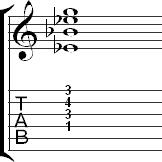
Minor Chords
Minor Chord
Chord Diagram

Comments
This chord is based on the first position D minor chord. The root is played on the second and fourth strings.
Tablature
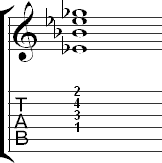
Major Seventh Chords
Shape 1: Maj7 Chord
Chord Diagram

Comments
This maj7 voicing is based on the open Amaj7 voicing in the lesson on seventh chords. The main difference is that the first string is omitted from the chord so that it can be moved around the neck. Try to angle your pinky so that it mutes the high E string to prevent it from ringing
The root is on the fifth string.
Tablature
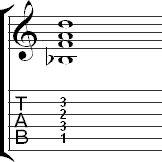
Shape 2: Maj7 Chord
Chord Diagram

Comments
The root is found on the sixth string in this maj7 chord. You need to angle your index finger so that it mutes the fifth string. This will take some practice to perfect, but will allow you to strum the chord without the fifth string ringing.
Tablature
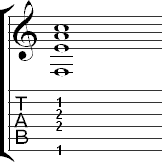
Dominant Seventh Chords
Shape 1: Dominant Seventh Chord
Chord Diagram

Comments
This chord has the same shape as the first maj7 voicing above, but moved to the fourth string. It is based on the open D7 chord learned in the seventh chord lesson. The root is on the fourth string.
Tablature
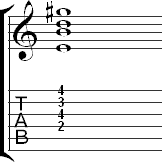
Shape 2: Dominant Seventh Chord
Chord Diagram

Comments
Compare this voicing to the second maj7 chord given above. There is only one note different between the chords, although the fingerings for both chords are very different. You also need to angle your index finger to mute the fifth string in this chord.
The root is on the sixth string.
Tablature
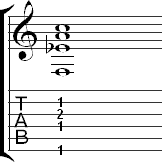
Shape 3: Dominant Seventh Chord
Chord Diagram

Comments
This dominant seventh shape comes from the first position C7 chord. The first string is left out of the chord to make it movable. Mute the first string with your index finger. You need to angle the finger so that you can fret the second string note while also muting the first string.
The root is on the second and fifth strings.
Tablature
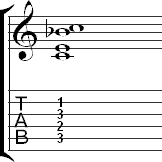
Minor Seventh Chords
m7 Chord
Chord Diagram

Comments
The movable m7 voicing is based on an open Dm7 chord. The root is found on the second and fourth strings.
Tablature
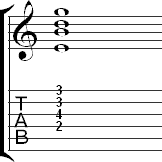
How to Move the Chords Around the Neck
Find the String Where the Root Occurs
The first step in moving a chord is to find the string (or strings) where the root occurs. In some chords, the root will occur on just one string, while in other voicings, it will occur two or more times. If the root occurs on more than one string, any of those strings may be used for moving the chord. The result will always be the same no matter which string you choose. For example, if a chord has the root on the second and fifth strings, you can use either of these strings to move the chord to another root.
The comments about the chord voicings above give the location of the root for every chord, so it should be easy to find the string where the root occurs.
Find the Root on that String
The next step is to find the root pitch of the chord you want to play on the string where the root of the chord is found. For example, if the root of the chord occurs on the fifth string and you want to play it with a root of E, you need to find an E on the fifth string. This requires knowing the notes on the guitar. E occurs on the fifth string at the seventh fret. Moving the chord so that the fifth string note occurs at the seventh fret will give you a chord with E as the root. Below is an example of this applied to the last dominant seventh voicing given above. The third finger frets the fifth string note (where the root occurs), so moving your third finger to this fret will give you an E7 chord.
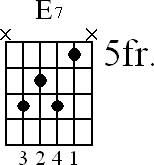

Comments
This voicing is based on a first position D major chord. The stretch may be difficult if you have small hands. Practice the chord higher on the neck at first if you find the stretch challenging.
The root is on the second and fourth strings, so you can move the chord by knowing the pitches on this string. For example, the chord shown here is an Eb major chord because it is played at the first fret.